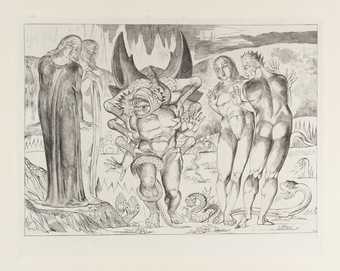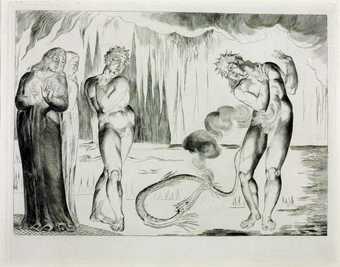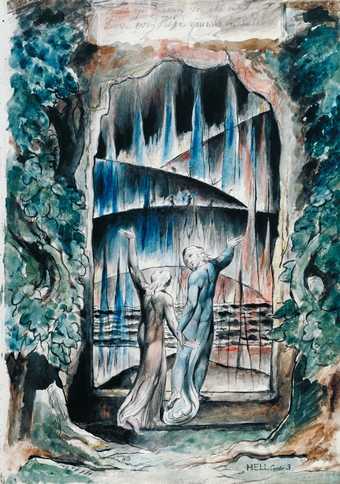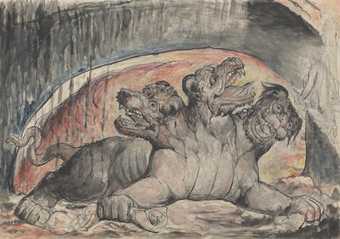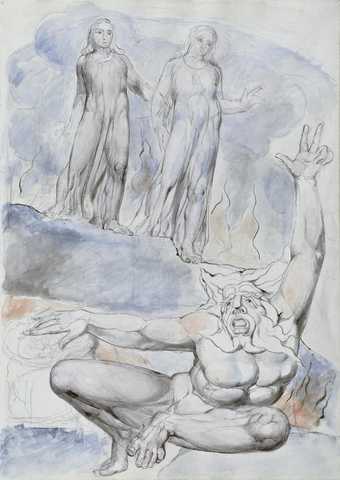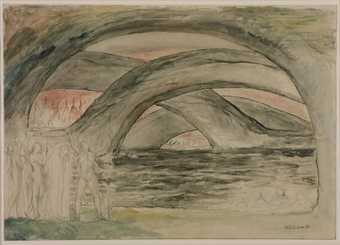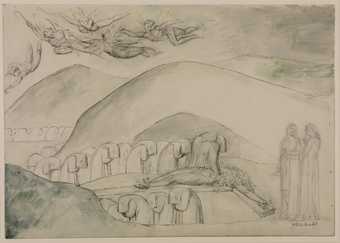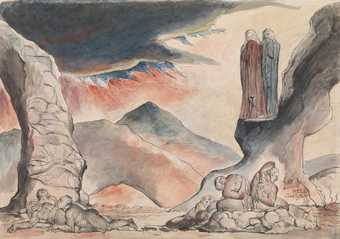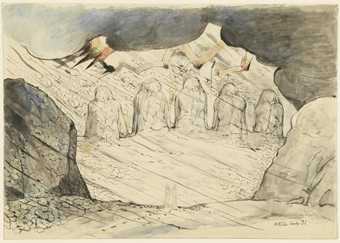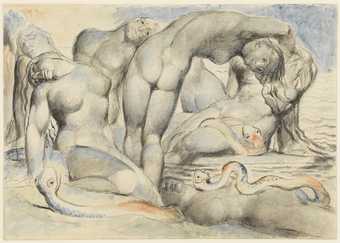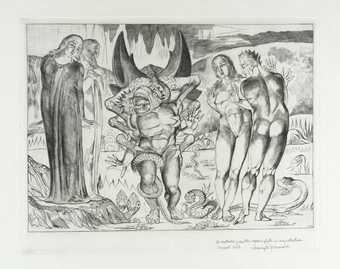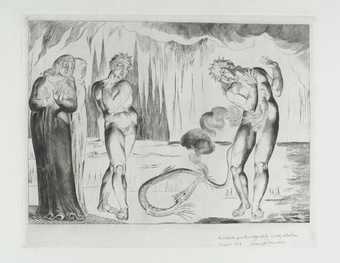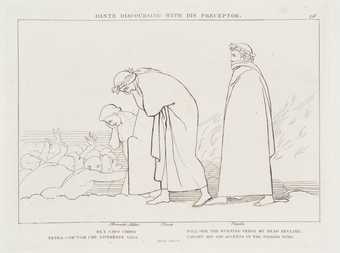
Not on display
- Artist
- William Blake 1757–1827
- Medium
- Ink and watercolour on paper. verso: graphite on paper
- Dimensions
- Support: 372 × 527 mm
- Collection
- Tate
- Acquisition
- Purchased with the assistance of a special grant from the National Gallery and donations from the Art Fund, Lord Duveen and others, and presented through the Art Fund 1919
- Reference
- N03361
Display caption
Gallery label, August 2004
Does this text contain inaccurate information or language that you feel we should improve or change? We would like to hear from you.
Catalogue entry
N03361 The Serpent Attacking Buoso Donati 1824–7 (recto)
Sketch of a Man with a Transparent Hood (?) over his Head 1824–7 (verso) [A00005-A00011; N03351-N03370; T01950-T01956; complete]
N 03361 / B 812 53
Recto: pen and watercolour; verso: pencil, approx. 55×25 (2 1/8×1); on paper 372×527 (14 11/16×20 3/4)
Inscribed ‘HELL Canto 25’ in ink b.r. and, on reverse in pencil, ‘72’ t.l., ‘N39 next at p.69’ t.c. turned through a right-angle and again in centre, and ‘HELL Canto 23’ b.r.
Watermarked ‘WE’
Purchased with the assistance of a special grant from the National Gallery and donations from the National Art-Collections Fund, Lord Duveen and others, and presented through the National Art-Collections Fund 1919
PROVENANCE As for N03351
EXHIBITED RA 1893 (14); Tate Gallery (41 xi), Manchester (48 xi), Nottingham (42 xvi) and Edinburgh (65) 1913–14; Paris and Vienna 1937 (22); Tate Gallery 1947 (58)
LITERATURE Rossetti 1863, p.219 no.101z1, and 1880, p.231 no.123z1; Roe 1953, pp.109–10 no.53, recto repr.; Klonsky 1980, p.149, recto repr. pl.56, verso p.21; Butlin 1981, p.572 no.812 53, verso pl.105b; Gizzi 1983, p.134 recto repr., and repr. in colour p.63; Fuller in Art History
1988, pp.369–70. Also repr.: Mizue, no.882, 1978, 9, p.36, recto only in colour
This is an illustration to Inferno XXV, 79–93, a scene in the seventh trench, that of the thieves, of the eighth circle. Francesco de' Cavalcanti, in the guise of a serpent, bites Buoso Donati with the result that Buoso turns into a serpent while Cavalcanti reverts to his human form; Puccio Sciancato looks on. The completion of the process of transformation shown in this watercolour is shown in the next work in this series, ‘Buoso Donati Transformed into a Serpent; Francesco de’ Cavalcanti Retransformed from a Serpent into a Man’, now in the Fogg Art Museum (Butlin 1981, no.812 54, repr. Roe 1953, pl.54, Klonsky 1980, pl.57 and Gizzi 1983, p.135).
This is one of the designs engraved by Blake (repr. Roe 1953, pl.53 E, Bindman 1978, pl.651 and Klonsky 1980, pl.107); see also A00009.
The small but clearly defined drawing on the back (lower right with the page held horizontally) shows the head and shoulders of a man in profile, his head in some kind of transparent hood or bubble, possibly in the process of being transformed into a serpent though no exact parallels can be found among the Dante drawings. There is no similarity to the hooded hypocrites of Canto XXIII as might be supposed from the reference to that Canto on the verso (see N03359).
Published in:
Martin Butlin, William Blake 1757-1827, Tate Gallery Collections, V, London 1990
Explore
- emotions, concepts and ideas(16,416)
-
- emotions and human qualities(5,345)
-
- horror(180)
- universal concepts(6,387)
-
- transformation(186)
- characters(438)
- actions: expressive(2,622)
-
- recoiling(65)
- hand / hands raised(143)
- standing(3,106)
- looking / watching(581)
- man(10,453)
- group(4,227)
- male(959)
- mythical, religious, fictional(260)
-
- Hell(93)
- Judaeo-Christian imagery(856)
-
- Hell(252)
- crime and punishment(431)
-
- thief(17)
You might like
-
William Blake The Six-Footed Serpent Attacking Agnolo Brunelleschi
1826–7, reprinted 1892 -
William Blake The Serpent Attacking Buoso Donati
1826–7, reprinted 1892 -
William Blake The Inscription over the Gate
1824–7 -
William Blake Cerberus
1824–7 -
William Blake Plutus
1824–7 -
William Blake The Simoniac Pope
1824–7 -
William Blake The Devils, with Dante and Virgil by the Side of the Pool
1824–7 -
William Blake The Hypocrites with Caiaphas. Verso: Sketch of a Stooping Figure
1824–7 -
William Blake The Laborious Passage along the Rocks
1824–7 -
William Blake The Pit of Disease: The Falsifiers
1824–7 -
William Blake The Primaeval Giants Sunk in the Soil
1824–7 -
William Blake The Punishment of the Thieves
1824–7 -
William Blake The Six-Footed Serpent Attacking Agnolo Brunelleschi
1826–7, reprinted 1968 -
William Blake The Serpent Attacking Buoso Donati
1826–7, reprinted 1968 -
After John Flaxman Dante Discoursing with his Preceptor
1807

